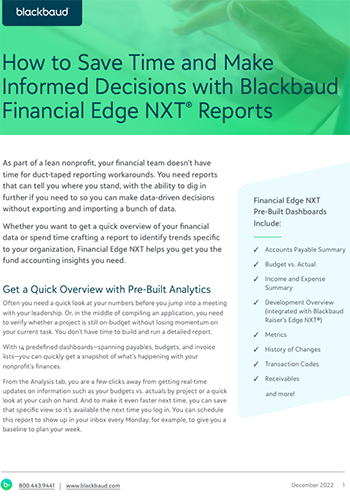Change is Inevitable: Budgets and How to Manage Changing Them

The Greek philosopher Heraclitus is credited with saying, “The only constant in life is change.” If recent events are any indicator, Heraclitus is not too far off. As leaders in nonprofit finance, it’s our job to be prepared for the inevitability of change.
How do we prepare for change? We build a budget that is fair, balanced, and built on evidential history, but flexible—ready for whatever hiccups and bumps come along.
I’m sure everyone is mildly familiar with budgeting. In my experience, the process begins with analyzing what has gone on in the past fiscal year (or two) and culminates with proposing budget amounts that are reasonable and a bit of a stretch goal. Meetings, approvals, and publication of the finalized budget are involved.
But what happens when, as Heraclitus says, “the constant” occurs? What do you do? How do you communicate the change in your plans, your budget? Because change is inevitable, knowing how to communicate with your internal and external stakeholders about a change is a key skill every nonprofit financial leader should have.
Why Do Nonprofit Budgets Change?
Before we dive into how to manage those changes, let’s start with a few scenarios of why your organization’s budget might change.
External Issues
A few things in recent years have caused us all to need to adjust our budgets. Pandemics, natural and man-made disasters, economic challenges, and governmental policy and funding changes are all potentially budget-tweaking scenarios.
Internal Issues
Leadership changes, departmental or program re-prioritizations, scope creep, revenue stream shifts, mergers, and separations are all possible internal adjustments that could cause a change in the budget.
Human Error
Human errors such as poor management or inadequate planning can necessitate a budget adjustment. While we don’t want to point a finger at one person causing a shift in budgeting, errors do occur.
These scenarios are not out of the ordinary. If you take a look at the issues that could cause budget changes, at least one of them has likely happened to you at some point in your career. We only have to look back a few months to encounter some of the external issues that caused major budget changes to many organizations worldwide.
Communicating Budget Changes: When, What, Why, and to Whom
The best thing to do when situations change is to communicate the changes as soon as you have a clear understanding of what is changing and why it is changing. Hiding a change, no matter how small or how embarrassing, is a recipe for disaster. Don’t try to cover up something that can easily be disclosed and clearly explained. Honest communication is the best policy.
What changes should be communicated? Those with impact. So, if a program will see significant service cuts, or a department will be credited with a large revenue boon, communication is in order. While more is probably better in these situations, you probably will communicate larger impact changes internally and externally while communicating smaller impact changes to your internal stakeholders only.
And while you probably already know, the “why” is because an ounce of prevention is worth a pound of cure. If you don’t control the conversation about your changes, the conversation will control you.
If you’re not sure who should be told about a change, consider having a conversation with your leadership team or board of directors.
Communicate Internally
It’s important for your internal stakeholders and any externally facing team members to know what has changed and why. Communicating a change internally should be done in advance of any external communications, because you do not want your team members to be presented with questions they cannot answer—and potentially have no knowledge of!
Your internal communications strategy should:
- Cite the issue. Provide a full disclosure and lay out the truth (always the truth).
- Describe the decision-making process in as much detail as necessary. Minute details may not be needed, but broad process steps could be helpful.
- Identify any significant impacts the change will have. Will certain expenses be cut, or will new areas become available?
If possible, consider delivering internal communication in person. If you are a remote-first workplace, consider an “all hands” meeting with a live feed. Then, of course, follow up with written communication, so your internal stakeholders have a resource to refer to moving forward.
Additionally, for each change listed, consider the content you generate may also be seen by a non-financial audience, so do your best to avoid finance jargon:
- “Jargony” statement: Due to Winter Storm Jack, our utilities expenses have dramatically increased, causing us to need to adjust our utility budgeted amounts for this month. We will evaluate our income to expense line items to identify deficiencies.
- Less “jargony” statement: Due to Winter Storm Jack, our utilities cost will be significantly higher this month. We may need to revisit our plans for spending and our fundraising needs.
Poll your staff and volunteers to see how they feel when they’re confronted with changes that need to be explained (or defended) to the public. Volunteer and staff insights may fuel ideas for how to better prepare in the future. Here are some questions you might consider asking:
- Do you feel you understand the underlying reasons for the budget changes?
- Have you ever been asked why we spent more on one project or less on another?
- How comfortable are you with answering budget questions?
- How can we clarify the reasoning for changes to better prepare you in the future?
Communicate Externally
So, you think you need to let the outside world know about the changes you’ve made to your budget. How do you approach that communication? Every situation is different so, again, if you have any doubts about how much to communicate, definitely do your due diligence.
Consider the following when building an external communication strategy:
- How can you frame the change positively without being disingenuous? Be clear about what’s happening, but you don’t want to be overly optimistic or pessimistic.
- How can you convey the most information with the least amount of finance-jargoned wording? No one wants to slog through a bunch of fancy words to learn that you must spend less because a natural disaster drained your funds.
- Can you include details without compromising privacy and organizational policies? If so, what details can you include safely?
- Do you need a dedicated phone number or generic email address to field questions regarding the change, or will you have a single point of contact to handle the public relations aspects?
As mentioned before, make sure your staff is ready to field questions and provide resources to appropriately answer those questions.
Here are some additional tips for going forward:
- Document any reactions you received from supporters regarding budget changes.
- You may want to address supporter reactions (positive and negative). Consider a personal phone call or an online meeting with supporters who have concerns.
- Supporter reactions can also be included in your future communications. However, when directly quoting a supporter, ensure you receive permission.
- Communication during challenging times can make or break your supporters’ attitudes toward your organization, so it’s important to be strategic.
Make sure you have a plan to get out in front of the public “chatter.” Consider steps you will take for specific channels, such as print media, social media, and traditional media.
In your approach, be proactive instead of reactive. Appearing to be reactive could give the impression you’ve got something to hide.
Provide Budget Transparency with Fund Accounting Software
Budget changes should be tracked in your financial accounting software. If there’s a method of adjusting your budget so you can maintain a budget audit trail, that would be best. Being able to create financial statements that show the shift mid-year in your financial strategy shows foresight, financial stewardship, and respect for your stakeholders.
For example, within Blackbaud Financial Edge NXT, you can add adjustments to your finalized budgets. Each budget adjustment allows you to annotate the reason for the change. You can create financial reports using the original budget, adjusted budget, or just the budget adjustments. If your financial software can manage budget change tracking, you will be able to look back at previous years’ budget changes and glean an understanding of what has happened and how you reacted.
Looking for more information about budgeting? Check out the on-demand webinar, 10 Ways Blackbaud Makes Budgeting Easier.
 Free Resource
Free Resource
Build Actionable Reports
How to Save Time and Make Informed Decisions with FENXT Reports


